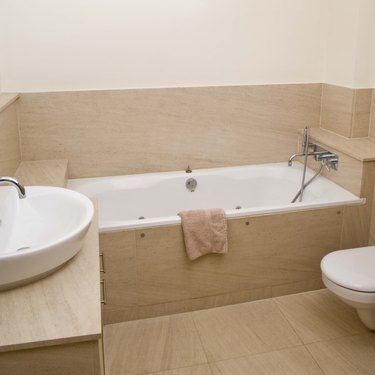 Caulking around bathtubs keeps moisture out of walls and floors. Image Credit: Jupiterimages/Comstock/Getty Images
Caulking around bathtubs keeps moisture out of walls and floors. Image Credit: Jupiterimages/Comstock/Getty Images
The bathroom is an integral part of your home that can be a source of unhealthy germs, mold and mildew if not cleaned and maintained regularly and properly. Although housecleaning is not a fun or glamorous task, it is especially important in the bathroom. Cleaning and sanitizing the toilet, sink and bathtub/shower prevent contamination, illness and disease. Growth of harmful organisms in the bathroom is often due to water and moisture. Caulking around the rim of the bathtub and other areas seals cracks and crevices that otherwise accumulate and hold water and moisture.
Video of the Day
What Is Caulk?
Caulk is a thick, sticky material that dries into a solid mass. It adheres to the surface where it has been applied and creates a waterproof barrier. It has many applications in building and construction, most involving sealing and finishing surfaces, joints and small separations. Caulk is available in silicone, rubber, latex and oil or resin base. The most common caulk used in bathrooms is silicone.
Reasons to Re-Caulk
Reasons to re-caulk around a bathtub include mold and mildew buildup behind the caulk surface and dried out, cracked and peeling caulk. If your tub has caulk that cracks or peels frequently within a year of application, you may have used the wrong type of caulking for the bathroom. Silicone caulk is the most common type of caulking used for watery and moist environments.
Old Caulk Removal and Site Preparation
Old caulk must be removed and the site cleaned and prepared before new caulk is applied for the best adhesion and appearance. Peel out the old caulk if possible, or use a softening agent to make it easier to remove. When all the old caulk is removed, clean the area with soapy water and rinse it with clear water. Apply a spray of bleach to sanitize the area and kill mold and mildew spores. Let the area dry thoroughly before applying new caulk. Use a mildew-resistant caulk in the bathroom.
How Long Does Caulk Last?
How long caulk lasts depends on several factors, including the type of caulk, the preparation and application process and the environmental conditions where it is applied. Improperly applied caulk will allow moisture and mildew in spaces that it is meant to seal, which will discolor the caulk material and require replacement sooner than if it had been properly applied. Caulk around a bathtub should be replaced if it is cracked or peeling or has a lot of mildew growing behind it, indicating leaks in the seal that are allowing moisture in.







































